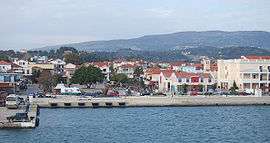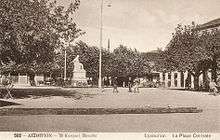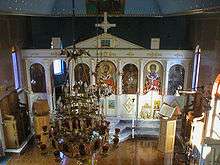Lixouri
Lixouri (Greek: Ληξούρι) is the main town on the peninsula of Paliki in the island of Kefalonia, one of the Ionian Islands of western Greece. Lixouri is the second largest community in Kefalonia after Argostoli and before Sami and is the capital of the peninsula. It is located south of Fiskardo and west of Argostoli.
Lixouri Ληξούρι | |
|---|---|
 | |
 Lixouri | |
| Coordinates: 38°18′N 20°25′E | |
| Country | Greece |
| Administrative region | Ionian Islands |
| Regional unit | Kefalonia |
| Municipality | Kefalonia |
| Municipal unit | Paliki |
| Population (2011)[1] | |
| • Rural | 3,752 |
| Community | |
| • Population | 4,301 (2011) |
| • Area (km2) | 14.521 |
| Time zone | UTC+2 (EET) |
| • Summer (DST) | UTC+3 (EEST) |
| Postal code | 282 00 |
| Area code(s) | 26710 |
| Vehicle registration | KEA-KEB |
| Website | www.paliki.gr |
History


The town was founded when citizens of Pale/Pali found a new location for a town. The old city was abandoned completely by the 16th century. The oldest document which contains the name "Lixouri" was sent in 1534 by local authorities to the Senate of Venice. In the 19th century Lixouri was a popular tourist destination; Richard Strauss visited the town. Many houses were destroyed in the earthquakes on January 23, 1867 and in August 1953. In the early 1950s the Royal Family of Greece sent their children for summer holidays to Lixouri. In the 1990s Lixouri increased in popularity as a tourist destination and some larger hotels were built south of the town near the beaches.
Literature
Lixouri is the home town of the poet and satirical author Andreas Laskaratos, who wrote about life in his home town. The Kay Cicellis book "Death of a Town" (1954) begins in Lixouri and describes the time of the earthquake. In 1720 Petros Katsaitis, who lived in Lixouri, wrote his play "Iphigenia"; Spyros Evangelatos' edition of the play in 1995 retitled it "Iphigenia in Lixouri". Ilka Chase wrote about the town in "The Varied Airs of Spring" (1969) as did Georges Haldas in "A la recherche du rameau d'or" (1976).
Infrastructure

Lixouri has a few primary schools and few middle schools (gymnasia), and high schools (lyceums). The 1st Primary School of Lixouri is one of the few buildings in the town that still stands from before the 1953 earthquake. The Technological Educational Institute of the Ionian Islands has a campus in Lixouri, where the department of Sound and Musical Instrument Technologies and the department of Business Administration are housed.[2]
The public library and a museum are located at the Iakovateios building, also preserved from before the earthquake.[3] Since 2003 Lixouri also has a theatre.
Transportation
Lixouri has a small port with a ferry to Argostoli (in peak season running every hour or half-hour) that is used for vehicles under 5 tons. In the summer, there is also service to Patras and Killini on the mainland. The KTEL bus service has a station in Lixouri and offers routes ending in Patras and Athens (via the port of Sami). Some Hotels offer own bus services e.g. from Lixouri to the XI-Beach and Kounopetra. One bus line drives twice a day through all villages of the peninsula Paliki but it is not very often used.
Demographics
| Year | Town population | Community population |
|---|---|---|
| 1981 | 3,004 | - |
| 1991 | 3,181 | - |
| 2001 | 3,610 | 3,940 |
| 2011 | 3,752 | 4,301 |
Subdivisions
The administrative subdivisions (the bold) and settlements of Lixouri ("Dimos Palikis) since 1997:
|
|
|
|
Matzavinata contains also the settlement Kounopetra and the island Vardiani and had with them the official name "Katogi".
Notable people
- Georgios Bonanos (1863–1940), sculptor
- Antiochos Evangelatos (1903–1981), Greek composer and conductor
- Marinos Geroulanos (1867–1960), surgeon
- Andreas Laskaratos (1811–1901), poet
- Elias Meniates (1669–1714), scholar and bishop
- Spyridon Marinatos (1901–1974) leading Greek archaeologist
- Dionysios Zakythinos (1905–1993), leading Greek Byzantinist
See also
References
- "Απογραφή Πληθυσμού - Κατοικιών 2011. ΜΟΝΙΜΟΣ Πληθυσμός" (in Greek). Hellenic Statistical Authority.
- "Cephalonia". www.teiion.gr. Retrieved 2019-10-23.
- "Iakovatios Library in Kefalonia, Greece - Greeka.com". Greekacom. Retrieved 2019-10-23.
External links
| Wikimedia Commons has media related to Lixouri. |